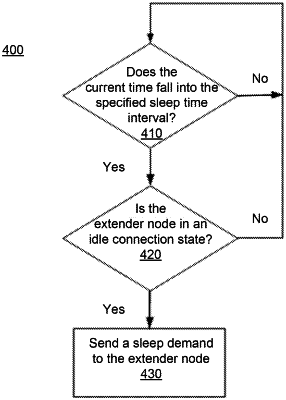| CPC H04W 52/0206 (2013.01) [H04W 16/26 (2013.01); H04W 52/0216 (2013.01); H04W 52/0219 (2013.01); H04W 52/0229 (2013.01); H04W 52/0235 (2013.01); H04W 52/0274 (2013.01)] | 17 Claims |

|
1. An electronic device that provides a wireless communication network to one or more clients via one or a plurality of extender nodes in a network, wherein the electronic device comprises:
a processor, and
a computer readable storage medium containing executable instructions that, when executed by the processor, cause the electronic device to be configured to:
identify a type of a client associated with the one or more clients, from a plurality of different types of clients, connected to a first extender node;
read a current time from a local clock;
determine whether the current time falls within a specified sleep time interval for a first extender node of the one or the plurality of extender nodes, wherein the electronic device is an access point that provides the plurality of extender nodes access to an external network, wherein the specified sleep time interval is selected by the electronic device based on the type, and wherein each of the plurality of different types correspond to a different specified sleep time interval and a different traffic threshold;
in response to determining that the current time falls within the specified sleep time interval, determine whether the first extender node is in an idle connection state, wherein the idle connection state includes the first extender node being not connected to any of the one or more clients or the first extender node being only connected to a sleeping client of the one or more clients; and
based at least in part on the idle connection state of the first extender node, sending a sleep command to the first extender node, wherein the sleep command instructs the first extender node to power off a wireless network interface for the wireless communication network of the first extender node.
|